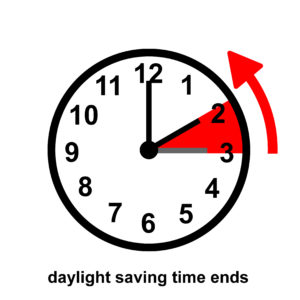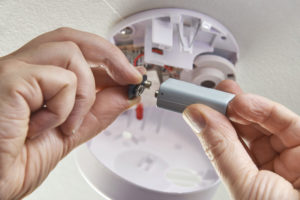Here are two great articles for getting ready for Daylight Savings Time! Make sure your HOME and YOURSELF are taken care of!
Make sure to continue to check back on our website for more helpful tips and tricks!
Your Go-2-Girl-4-Real-Estate, Pam Heinrich
Daylight Saving Time: 5 Things Every Homeowner Should Do
 It’s that time of year again. The weather’s getting cooler, and the days are getting shorter. And, on the first Sunday in November, it’ll be time to turn your clock back an hour as Daylight Saving Time ends.
It’s that time of year again. The weather’s getting cooler, and the days are getting shorter. And, on the first Sunday in November, it’ll be time to turn your clock back an hour as Daylight Saving Time ends.
Ah yes: Daylight Saving Time. When it begins in March, it’s the bane of everyone’s existence. But when it comes to a close in November, it’s always a welcome ritual. After all, turning back your clock an hour means an extra hour of sleep to start the work week. The end of Daylight Saving Time marks the holiday season soon to come. And there’s something about a sudden shift in daylight hours–with the evening darkness arriving an hour sooner than we’re used to–that seems to make fall just a bit more official. It’s an all-around winner.
For homeowners, Daylight Saving Time is an opportunity to perform important annual upkeep on your home. If you make a habit of taking care of these things the first Sunday of every November, you can rest assured that you’ll be prepared for the coming year. Read on to learn what you can do each year to transition your home smoothly into the fall, winter, and beyond.
Often the subject of great debate, Daylight Saving Time has been around in the US since 1918. Here are more fun facts you may not know about DST.
Turn your clocks back an hour when Daylight Saving Time Ends
This is a pretty obvious one. Nowadays, though, with our cell phones, computer, and tablets changing their time automatically, it can be easy to forget that you need to turn back your home clocks yourself. So, remember: switch back the clocks on the stove, microwave, and wall by a full hour. You’ll thank yourself the following morning when you avoid any potential moments of “wait, what time is it?” panic.
Change the batteries in your smoke alarm

Ever been sleeping peacefully through the night, only to be awoken by a bizarre, confusing, intermittent chirping sound? You roll out of bed, thoroughly disheveled, and wander the rooms of your home. Finally, you discover the source: a low battery in one of your smoke detectors. While the aforementioned scenario is reason enough to switch out your smoke detector batteries every year, there’s a more important reason: a smoke detector with adequate battery power can detect smoke from a fire, and save your life. One without power can’t. So, use the end of Daylight Saving Time as an annual reminder to change your smoke alarm batteries.
Check your furnace and water heater
Many furnaces need annual maintenance: use the end of DST as a reminder to schedule it. If nothing else, be sure to switch out the air filter (especially with winter just around the corner). While you’re in the utilities area of your home, check your hot water heater for any signs of leaking.
Clean your gutters
No one likes cleaning gutters. We get it. But what’s worse than cleaning gutters? Doing it in the dead of winter. With the potential of ice and snow in some parts of the county just around the corner, the end of Daylight Saving Time is a great time to get out the ladder and remove the leaves and other debris from your gutters.
Restock your Emergency Kit

An emergency kit is essential in every home, and the end of Daylight Saving is a great time to check its content and restock it. It’s likely your emergency kit has been depleted if you live in one of the areas affected by the 2017 hurricane season. If you’re not sure what to include in an emergency kit, take a look at our hurricane kit checklist which includes everything you’ll need and more. And, you’ll be one step ahead when next year’s season rolls around!
With these tasks out of the way, enjoy that extra hour of sleep! You’ve earned it.
5 Tips for Dealing With Daylight Saving Time
Don’t forget to change your clocks. If you noticed you had an easier time getting out of bed this morning, you have Mother Nature to thank.
As of 2 a.m. on Sunday, November 4, daylight saving time officially ended. The clocks fell back an hour, meaning sunrise and sunset times will be an hour earlier.
The good news — for now, at least — is that most people struggle more with losing an hour of sleep in the spring.
The bad news? Many of us are going to have a harder time falling asleep the next few days as we adjust our schedules to the time change.
The reason the start and end of daylight saving time can throw us for such a loop boils down to our circadian rhythm — an internal clock that manages our sleep-wake cycle.
Your circadian rhythm is the reason you may feel alert in the morning, groggy in the afternoon, and zonked by bedtime.
It works best when you have a set routine and stable sleep habits. When your circadian rhythm is thrown out of whack, as it is with daylight saving time, sleep disruptions are likely to occur.
Research has shown time and time again that sleep protects us from physical and mental harm.
Without sleep, we’re more prone to craving unhealthy, high-calorie foods, and we’re less likely to exercise. This combination can cause you to feel more irritable and less productive. Not to mention, the more sleep-deprived you are, the more likely you are to get sick.
“It’s important not to underestimate the importance of sleep, especially with the time change marking the end of daylight saving time,” Dr. Jose Puangco, a neurologist specializing in sleep medicine at the Pickup Family Neurosciences Institute at Hoag Hospital in Newport Beach, told Healthline.
“The time change can disrupt your circadian rhythm, and the brain needs a little prep time to get used to this new schedule,” he added.
Turn off all electronics an hour before bedtime, Puangco recommended. Resist the urge to check your email, watch Netflix, or read your Kindle, as these activities can keep you feeling alert and stimulated.
“Light from TVs, computers, tablets, and cellphones can suppress melatonin and affect the quality of your sleep,” Puangco said.
Absolutely need to send out that email before you hit the sack? Try dimming the display light on your phone or computer.
Electric devices emit tons of blue light, which tricks your brain into thinking it’s daytime. If you often have to work at night, purchase a pair of blue-blocking glasses or install an app like f.lux, which automatically adjusts the color and brightness of your screen based on your current time zone.
Many of us depend on our morning cup of coffee to help get our days going — and there’s nothing wrong with that. But if you’re constantly refilling your mug throughout the day, you may want to cut back.
“Avoid any caffeine after lunchtime,” Puangco said. “The effects of caffeine can linger for many hours after being consumed and can hinder you from sleep.”
In fact, even if you drink caffeine six hours before bedtime, you’re still likely to lose a full hour of sleep, according to a study published in the Journal of Clinical Sleep Medicine.
Many people struggle with falling asleep an hour earlier when the clocks fall back. Counting sheep can only do so much.
Some health experts recommend gradually easing into the time change.
“Slowly shift your bedtime by 15 minutes each night. This will allow your body to naturally adjust when the clocks turn back,” Dr. Beth Donaldson, a family physician at Copeman Healthcare Centres in Vancouver, said.
For example, maybe tonight you go to bed 15 minutes earlier, and then tomorrow night you aim for 30 minutes earlier. Within a week or so, you should be back on track.
Once you’ve eased into it, make a point to go to bed and wake up at the same time every day — even on the weekends. This will help your body regulate its sleep cycle.
Additionally, just because you’re getting an hour back doesn’t mean you should stay up later and fill the time with extra activities.
Significantly switching up your sleep patterns increases your risk of being affected by the daylight saving time change, Donaldson explained.
If you begin to feel sleep-deprived, a nap may be in order.
“If you feel sleepy in the afternoon, take a nap, but avoid sleeping in in the mornings as this will only prolong your body’s reaction to the time change,” Donaldson said.
However, don’t nap too close to bedtime — as this can interrupt your sleep overnight — and try to keep your naps to 30 minutes or less.
All in all, don’t be alarmed if you catch yourself feeling out of sorts this week.
Daylight saving transitions can throw off your body’s circadian rhythm. Your body clock will eventually adjust to the time change — it may just need a little TLC to get there.
ARTICLES FROM HeritagePCI.com & Healthline.com


